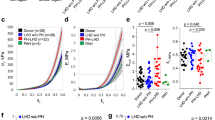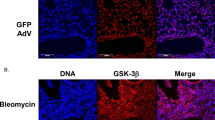Abstract
Progression of pulmonary hypertension is associated with increased serine elastase activity and the proteinase-dependent deposition of the extracellular matrix smooth muscle cell survival factor tenascin-C (refs. 1,2). Tenascin-C amplifies the response of smooth muscle cells to growth factors3, which are also liberated through matrix proteolysis4. Recent organ culture studies using hypertrophied rat pulmonary arteries have shown that elastase inhibitors suppress tenascin-C and induce smooth muscle cell apoptosis5,6. This initiates complete regression of the hypertrophied vessel wall by a coordinated loss of cellularity and extracellular matrix. We now report that elastase inhibitors can reverse advanced pulmonary vascular disease produced in rats by injecting monocrotaline, an endothelial toxin. We began oral administration of the peptidyl trifluoromethylketone serine elastase inhibitors M249314 or ZD0892 21 days after injection of monocrotaline. A 1-week treatment resulted in 92% survival, compared with 39% survival in untreated or vehicle-treated rats. Pulmonary artery pressure and muscularization were reduced by myocyte apoptosis and loss of extracellular matrix, specifically elastin and tenascin-C. After 2 weeks, pulmonary artery pressure and structure normalized, and survival was 86%, compared with 0% in untreated or vehicle-treated rats. Although concomitant treatment with various agents can reduce pulmonary hypertension7, we have documented complete regression after establishment of malignant monocrotaline-induced disease.
This is a preview of subscription content, access via your institution
Access options
Subscribe to this journal
Receive 12 print issues and online access
$209.00 per year
only $17.42 per issue
Buy this article
- Purchase on Springer Link
- Instant access to full article PDF
Prices may be subject to local taxes which are calculated during checkout



Similar content being viewed by others
References
Rabinovitch, M. in Comprehensive Cardiovascular Medicine (ed. Topol, E.J.) 3001–3029 (Lippincott-Raven Publishers, Philadelphia, 1998).
Jones, P.L., Cowan, K.N. & Rabinovitch, M. Tenascin-C, proliferation and subendothelial accumulation of fibronectin in progressive pulmonary vascular disease. Am. J. Pathol. 150, 1349–1360 (1997).
Jones, P.L., Crack, J. & Rabinovitch, M. Regulation of tenascin-C, a vascular smooth muscle cell survival factor that interacts with the αvβ3 integrin to promote epidermal growth factor receptor phosphorylation and growth. J. Cell Biol. 139, 279–293 (1997).
Thompson, K. & Rabinovitch, M. Exogenous leukocyte and endogenous elastases can mediate mitogenic activity in pulmonary artery smooth muscle cells by release of extracellular matrix-bound basic fibroblast growth factor. J. Cell Physiol. 166, 495–505 (1995).
Cowan, K.N., Jones, P.L. & Rabinovitch, M. Regression of hypertrophied rat pulmonary arteries in organ culture is associated with suppression of proteolytic activity, inhibition of tenascin-C, and smooth muscle cell apoptosis. Circ. Res. 84, 1223–1233 (1999).
Cowan, K.N., Jones, P.L. & Rabinovitch, M. Elastase and matrix metalloproteinase inhibitors induce regression and tenascin-C antisense prevents progressive vascular disease. J. Clin. Invest. 105, 21–34 (2000).
Mitani, Y., Maruyama, K. & Sakurai, M. Prolonged administration of L-arginine ameliorates chronic pulmonary hypertension and pulmonary vascular remodeling in rats. Circulation 96, 689–697 (1997).
Seliem, M.A., Wu, Y.T. & Glenwright, K. Relation between age at surgery and regression of right ventricular hypertrophy in tetralogy of Fallot. Pediatr. Cardiol. 16, 53–55 (1995).
Haas, T.L. & Madri, J.A. Extracellular matrix-driven matrix metalloproteinase production in endothelial cells: implications for angiogenesis. Trends Cardiovasc. Med. 9, 70–77 (1999).
Ye, C. & Rabinovitch, M. Inhibition of elastolysis by SC-37698 reduces development and progression of monocrotaline pulmonary hypertension. Am. J. Physiol. 261, H1255–H1267 (1991).
Fried, R. & Reid, L.M. Early recovery from hypoxia pulmonary hypertension: a structural and functional study. J. Appl. Physiol. 57, 1247–1253 (1984).
Wigle, D. et al. Aml-1 like transcription factor induces serine elastase activity in bovine pulmonary artery smooth muscle cells. Circ. Res. 83, 252–263 (1998).
Jones, P.L., Jones, F.S., Zhou, B. & Rabinovitch, M. Denatured type I collagen induction of vascular smooth muscle cell tenascin-C gene expression is dependent upon a β3 integrin-mediated mitogen-activated protein kinase pathway and a 122 base pair promoter element. J. Cell Sci. 112, 435–445 (1999).
Choi, E.T. et al. Inhibition of neointimal hyperplasia by blocking αVβ3 integrin with a small peptide antagonist GpenGRGDSPCA. J. Vasc. Surg. 19, 125–134 (1994).
Brooks, P.C. et al. Integrin αvβ3 antagonists promote tumor regression by inducing apoptosis of angiogenic blood vessels. Cell. 79, 1157–1164 (1994).
Stromblad, S., Becker, J.C., Yebra, M., Brooks, P.C. & Cheresh, D.A. Suppression of p53 activity and p21WAF1/CIP1 expression by vascular cell integrin αvβ3 during angiogensis. J. Clin. Invest. 98, 426–433 (1996).
Eliceiri, B.P., Klemke, R., Stromblad, S. & Cheresh, D.A. Integrin αvβ3 requirement for sustained mitogen-activated protein kinase activity during angiogenesis. J. Cell Biol. 140, 1255–1263 (1998).
Bader, B.L., Rayburn, H., Crowley, D. & Hynes, R.O. Extensive vasculogenesis, angiogenesis, and organogenesis precede lethality in mice lacking all αv integrins. Cell. 95, 507–519 (1998).
Edwards, P.D. et al. Discovery and biological activity of orally active peptidyl trifluoromethyl ketone inhibitors of human neutrophil elastase. J. Med. Chem. 40, 1876–1885 (1997).
Lee, J.-K. et al. A serine elastase inhibitor reduces inflammation and fibrosis and preserves cardiac function after experimentally-induced murine myocarditis. Nature Med. 4, 1383–1391 (1998).
Acknowledgements
We thank J. Klein and L. Morikawa for technical assistance, D. Osmond of the Department of Physiology, University of Toronto for systemic pressure measurements, as well as the Laboratory Animal Services staff at the Hospital for Sick Children. We also thank J. Jowlabar, J. Matthews and J. Edwards for secretarial assistance. This work was supported by grants from the Heart and Stroke Foundation of Canada grant #3170, the Medical Research Council of Canada grant #PG13920 and the Primary Pulmonary Hypertension Cure Foundation. M.R. is a research endowed chair of the Heart and Stroke Foundation. K.N.C. holds a K.M. Hunter/Medical Research Council of Canada doctoral fellowship.
Author information
Authors and Affiliations
Corresponding author
Rights and permissions
About this article
Cite this article
Cowan, K., Heilbut, A., Humpl, T. et al. Complete reversal of fatal pulmonary hypertension in rats by a serine elastase inhibitor. Nat Med 6, 698–702 (2000). https://doi.org/10.1038/76282
Received:
Accepted:
Issue Date:
DOI: https://doi.org/10.1038/76282
This article is cited by
-
Blood DNA methylation profiling identifies cathepsin Z dysregulation in pulmonary arterial hypertension
Nature Communications (2024)
-
CRISPR-mediated Bmpr2 point mutation exacerbates late pulmonary vasculopathy and reduces survival in rats with experimental pulmonary hypertension
Respiratory Research (2022)
-
Nets, pulmonary arterial hypertension, and thrombo-inflammation
Journal of Molecular Medicine (2022)
-
Clonal hematopoiesis with JAK2V617F promotes pulmonary hypertension with ALK1 upregulation in lung neutrophils
Nature Communications (2021)
-
17β-estradiol preserves right ventricular function in rats with pulmonary arterial hypertension: an echocardiographic and histochemical study
The International Journal of Cardiovascular Imaging (2019)



